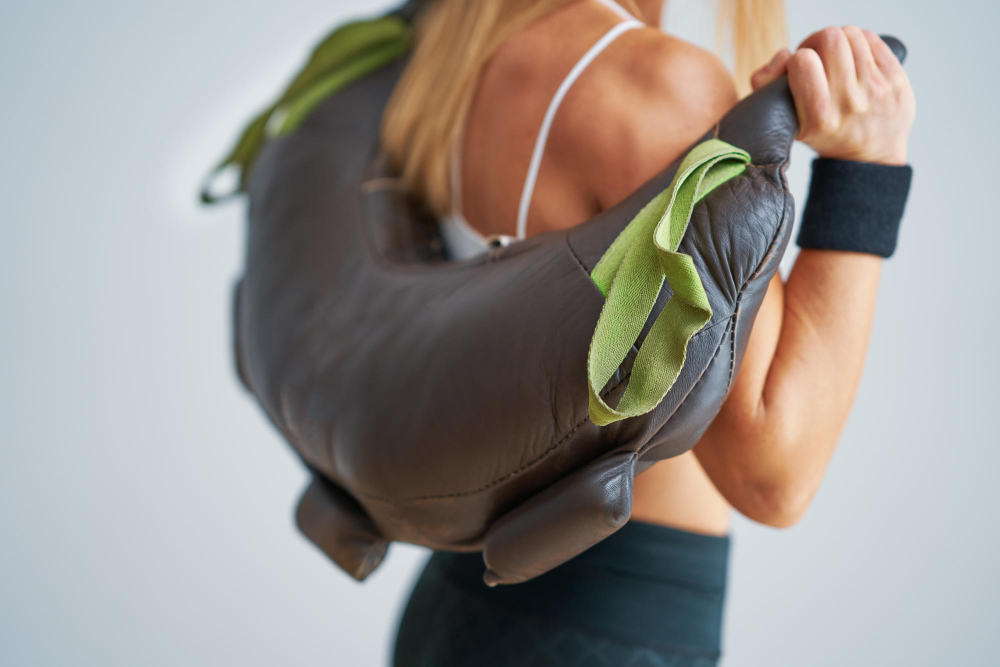If you want strength that actually works outside the gym, not just in front of a mirror, grab a sandbag. Every rep demands balance, control, and coordination. Your entire body has to move as one.
In this post, you’ll learn one complete full-body sandbag workout that’s simple, efficient, and brutally effective. Do it consistently and you’ll move stronger, steadier, and sharper than ever.
What Makes Sandbag Training So Effective for Functional Strength
Sandbag training hits differently. A barbell or dumbbell gives you predictable resistance, but a sandbag refuses to stay still.
That instability is the secret. It builds adaptability. Every rep teaches your body how to stay strong under pressure and keep control when things aren’t perfectly aligned.
Here’s what makes sandbags so effective:
- Total-Body Engagement: You’re not isolating one muscle at a time. Every move involves your whole body working together.
- Core Activation: The shifting load means your core has to stabilize during every rep.
- Grip and Forearm Power: Sandbags force your hands and forearms to work harder than traditional weights.
- Real-World Strength: Life doesn’t hand you evenly balanced objects. Sandbag training gets you ready for that.
The Full Body Sandbag Workout
Here’s what you need:
- Equipment: One sandbag (40 to 60 pounds for most people).
- Format: Choose between a strength version with sets and reps or a conditioning version done in circuits.
- Goal: Move with control and purpose. Focus on quality movement, not speed.
The workout includes five movements that deliver a complete full-body challenge:
- Sandbag Clean to Squat: Power and control through your hips and legs.
- Bear Hug Carry: Posture, grip strength, and total-body stability.
- Sandbag Push Press: Upper-body power and coordination.
- Over-the-Shoulder Toss: Explosive movement and rotational strength.
- Plank Drag (Sandbag Swipe): Core stability and anti-rotation control.
How to Put It All Together
If your goal is raw, functional power, this is the version to follow.
- Sandbag Clean to Squat: 4 sets of 6 to 8 reps.
- Sandbag Push Press: 4 sets of 8 reps.
- Bear Hug Carry: 4 carries of 30 to 40 steps.
- Over-the-Shoulder Toss: 3 sets of 10 reps (5 per side).
- Plank Drag (Sandbag Swipe): 3 sets of 10 to 12 drags per side.
- Rest: Take 90 to 120 seconds between sets.
If your goal is to burn calories, improve endurance, and keep your heart rate up, this version will test your grit.
Perform each movement for 45 seconds, rest 15 seconds, then move on to the next exercise.
Complete 3 to 4 rounds total, resting 60 to 90 seconds between rounds.
- Sandbag Clean to Squat
- Bear Hug Carry
- Sandbag Push Press
- Over-the-Shoulder Toss
- Plank Drag (Sandbag Swipe)
Pro Tip: Choose a lighter sandbag than you’d use for strength work so you can move fast without losing form.
FAQ
How often should I do this workout?
Two to three times a week is ideal. That’s enough to build strength, stability, and endurance without burning yourself out. If you’re combining this with other training like running, cycling, or lifting, keep at least one rest day between sandbag sessions to let your core and grip recover.
Do I need to warm up before sandbag training?
Absolutely. A proper warm-up is non-negotiable. Sandbag work demands a lot from your joints and stabilizers, so take 5 to 10 minutes before starting. Focus on dynamic moves like hip circles, arm swings, bodyweight squats, and light deadlifts with the empty bag.
How do I know when to increase weight or intensity?
If you can complete all sets with perfect form and still feel like you had several reps left in the tank, it’s time to level up. You can increase intensity by adding 5 to 10 pounds to the bag, adding one more round, or reducing rest time.
Key Takeaways on Full Body Sandbag Workout
You don’t need a full gym to build real strength. You just need one bag, a little space, and consistency.
- Sandbag training builds real-world strength. Every rep demands balance, control, and coordination.
- Instability is the advantage. The shifting weight forces your body to adapt, strengthening your core, grip, and stabilizers in every movement.
- Train with intent. Whether you choose the strength version or the conditioning circuit, move with focus and purpose.
- Stay consistent. Two to three sessions per week are all you need to build functional strength that carries into everyday life.





